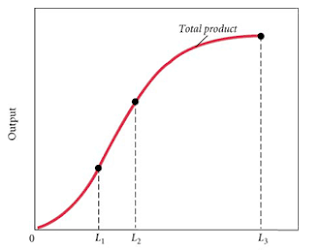Watermelons, more watermelons
If we could plot "global anxiety over the end of times" (the end of human times, that is) on a time series graph, I would say that now we would be at --or close to-- an all-time high. Typhoon Yolanda's epic size and strength is indeed a reminder of how insignificant we are, which definitely does not help to calm that feeling of impending doom.
End-of-the-world anxiety takes different forms. Economically speaking, the specter deflation is one of them. The New Normal, or the idea that we have reached a point from whence we will never achieve the growth rates of yesteryear is another. This idea, defined as a statistical regime change, can also be described as an inflection point, or the point at which the speed of growth decelerates going forward. In other words, the point at which the second derivative of GDP turns negative.
 |
| The New Normal: The second derivative (the slope's rate of change) turns negative at L1 |
The reason this inflection point occurs is very intuitive. I remember vividly when my Introduction to Microeconomics professor back in the 90's made her case to explain this quirk in the graph: "Imagine you have a piece of land of 1 hectare dedicated to watermelons," she said in her annoying Fran Drescher voice, "the production growth of that land will increase very rapidly as you add the first farm workers, but it will increase less rapidly as you add more and more workers, to the point of saturation. Then, production will actually decrease," she said, drawing an impossibly large amount of stick figures inside the most irregular square that could pass for a piece of arable land on the blackboard. She was talking about the marginal product of labor and how it peaks (at L1 in the graph above) and then becomes negative (at L3).
 |
| Source: Wikipedia |
At its most basic level, complex (civilized) human life on this planet can be defined as our quest to extract production from our one primordial resource (earth) to satisfy our immediate consumption needs. If we take the inverse of the marginal product mentioned above, then we are really talking about the amount of effort (labor) required to produce one additional unit --or marginal cost. The fact that each watermelon produced costs increasingly more is simply a consequence of using a real life, decaying natural resource (land).
We are nothing more than a very big group of farm workers exploiting a naturally decaying, finite piece of arable land. Luckily for us, several iterations of disruptive technology have allowed us to squeeze more watermelons out of our piece of land every time we've reached a saturation point in the past. But somehow, this time seems different. The generation currently graduating from college is being forced to put in more effort in exchange for the same (and sometimes, worse) entry-level jobs than earlier generations. Attaining the same standard of living as generations past is getting harder and harder for millenials around the world--narcissistic inclinations aside. This situation has unleashed an educational arms race, driving college students to accumulate staggering amounts of student loans with the hopes to gain a better life.
 |
| Source: Charles Hugh Smith |
 |
| Source: Own calculations |
No wonder doom and gloom pervades. Maybe this saturation is the reason behind the economic paradox that turns population growth downwards precisely when you'd expect the opposite. Maybe this is the mystical inter-generational, self-correcting mechanism that keeps us in check. What is clear, is that the model of growth is becoming exhausted, and somehow we are in the middle of a transition period in which we will either redefine our conception of "prosperity" --a postulate that scares many people-- or find the next technology iteration that will deliver the next round of watermelons --until that round becomes consumed, starting the whole thing again.
I just hope it's not too late by then.
I just hope it's not too late by then.

Comments
Post a Comment